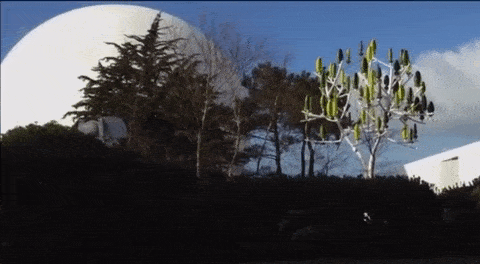To the romantic eye, a tree swaying in the wind is a testimony of nature’s heart beat. An engineer might be moved by the same feeling, but he might also add: “well, that looks like a lot of wasted energy.” A lot of large structures vibrate, hence generate energy, besides trees also, from bridges, to buildings, to the suspensions system of vehicles. Inspired by twigs in the wind, a team of researchers at Ohio State University are designing artificial mechanical trees that generate electricity. The output is very, very small but it’s enough to power some very helpful sensors, and in the future more energy per area could be possible. For now, it looks like a great application in those situations where solar panels aren’t an option.
A twig, a trunk and a PVDF
The researchers aren’t the first to think of using the natural oscillations of trees to generate electricity. Most believe however that it is useless since it’s inherently random motion. Ryan Harne, assistant professor of mechanical and aerospace engineering at Ohio State, begged to differ. He and colleagues mathematically modeled a tree-like structure and found that despite large, random inputs, it is indeed possible to maintain a constant frequency. Further on, Harne learned that by exploiting the structure’s internal resonance (the frequencies at which it will vibrate if physically disturbed), it is possible to coax an electromechanical tree to vibrate with large amplitudes at a consistent low frequency, even when the tree was experiencing only high frequency forces.
During an experiment, an electromechanical ‘tree’ was devised out of two small steel beams—one a tree “trunk” and the other a “branch”—connected by a strip of an electromechanical material, polyvinylidene fluoride (PVDF), to convert the structural oscillations into electrical energy. The setup was placed on a bench with oscillated the mechanical tree back and forth. The PVDF produced 0.8 volts.

Elsewhere in France, engineers demonstrated the Wind Tree: 72 artificial leaves serving as micro-turbines spinning on a vertical axis, the device will capture energy from winds with speeds as low as 2 meters / second. It can generate 3.1 KW. Read more.
Then, the team added noise to the system — random and slight nudges in multiple directions, akin to the wind that vibrates a tree outside. What happened was high frequency energy was channeled into low frequency oscillation, and the the trunk and branch vibrated in sync. This significantly improved the output and the system produced around 2 volts.
“Buildings sway ever so slightly in the wind, bridges oscillate when we drive on them and car suspensions absorb bumps in the road,” Harne said. “In fact, there’s a massive amount of kinetic energyassociated with those motions that is otherwise lost. We want to recover and recycle some of that energy.”
Though the voltage is tiny, it’s a great proof of concept that the random oscillations a tree experiences on a daily basis can be harvested. Replace tree with any vibrating structure and it’s basically the same thing. Harne and colleagues envision small, but useful mechanical trees placed through all sorts of locations where conventional off-grid energy generation systems (solar panel, wind turbine etc.) aren’t viable. These could power sensors that monitor the structural integrity of a bridge, for instance, without the hassle of drawing power lines or replacing batteries.
Findings were presented in a paper published in Journal of Sound and Vibration.










